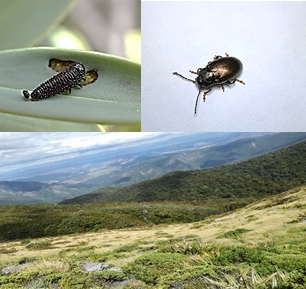PESTS AND DISEASES OF FORESTRY IN NEW ZEALAND
Hunt for the wilderbeetles
From Forest Health News 280, March 2018.
Scion entomologists and ecologists spent three weeks in Kahurangi National Park this last summer with a DOC permit to search for a group of native beetles that very little is known about. The search was part of efforts to complete host testing of the parasitoid Eadya daenerys, the proposed new biological control agent for eucalyptus tortoise beetle that targets the larval life stage. To date the only effective agents established in New Zealand are egg parasitoids.

We hoped to collect native larvae from the leaf beetle subfamily (Chrysomelinae) to test whether the parasitoid would try to sting the natives. Armed with only a few vague notes from decades old collections, the first search, starting in November, unfortunately turned up nothing. We were particularly hoping we would find the largest species called Chalcolampra speculifera, last reported in the 1970s as burrowing into stem swellings on leatherwood (Olearia lacunosa). There were also reports of beetles beaten off Hebe and alpine Celmisia. So all these plants were systematically visually inspected.
The second search, in mid-December, began with low expectations, but was a stunning success! During the second search, Matt Scott and Andrew Pugh visited a number of different sites around the Mt Arthur area, including a large site just behind the hut we stayed in. Over 120 larvae of a single (probably new to science) species were located scouring the surface of Veronica (Hebe), and successfully brought back to Rotorua for host testing in our Containment lab.
Day and night searches allowed the crew to make useful notes on the biology and host plant range to increase our overall understanding of this little studied group.
A further search in early January turned up a handful of larvae in the Cobb Valley area, but persistent heavy rain impacted the search. A publication is being prepared that will introduce this new species to the world and propose a scientific name for it.
Andrew Pugh & Toni Withers (Scion)

 Farm Forestry New Zealand
Farm Forestry New Zealand

